Grooming, nobility, elegance add beautiful sidewalk paths to the site. They carry not only practical functions. Paths give homeownership aesthetics. Combining all the buildings, they form a single ensemble. In addition, the paths zone the site, separating outbuildings, a vegetable garden, a flower garden, and a recreation area. Their competent organization allows you to correct some inaccuracies and shortcomings of the terrain.
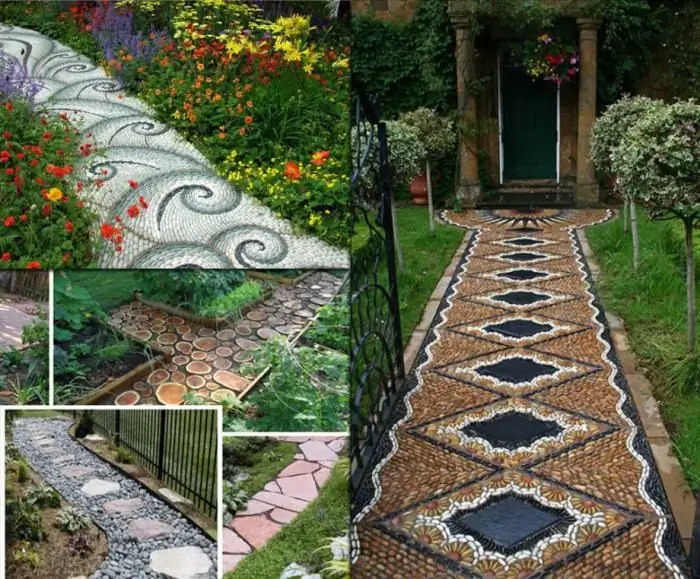
Track design
Initially, you should carefully consider the layout of the paths. Make a drawing and plan where the sidewalk will lead. In the case of a small area, designers recommend organizing them “to nowhere.”
If the area is impressive enough and allows you to plant flowers, fruit trees, shrubs - paths must be planned in those places where households will most often walk. They can lead to a bench, water source, beds, raspberries.
At the same time, it is very importantso that your paths do not have visible dead ends and do not rest against the fence. Thinking through the design, try to connect all the paths with each other. Also, do not forget that they should not stand out from the overall color scheme.
Determining the material
Modern pavement can be made from a wide variety of components. Therefore, the next step in creating a path is the choice of the appropriate material. To find the most suitable, you should study the advantages and disadvantages of the most common options.
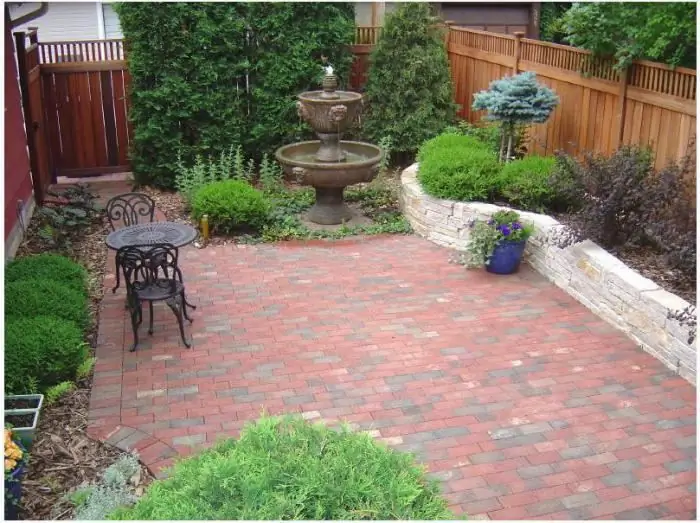
The most popular materials used to make walkways are:
- Brick. This is a strong, reliable material. However, one should not forget that ordinary house bricks or facing bricks are not suitable for the track. Since the first crumbles under the influence of weather conditions, and the second after snow or rain becomes slippery. There is a special brick for the paths. The use of such material allows you to create various patterns, patterns on the tracks. To realize your plan, the brick can be laid flat, edgewise. A significant drawback of the material is its high price.
- Blocks or paving clinker. Such material is made from clay or concrete mix. Sidewalk clinker is produced in different colors, different shapes. You can choose a material that has zigzag edges, with which the tiles are connected. It is durable and reliable, and is of high quality. However, it is also worthexpensive.
- Concrete. This is a fairly cheap road material. A big plus is its strength and durability. Such a coating does not need special care. To make the track attractive, you can add a dye to the solution, or apply interesting patterns, drawings, lines to the finished surface. If we talk about the shortcomings, it should be noted that an assistant will be needed to lay the concrete path, since one person will not be able to cope.
- Gravel. The paths paved with this material are quite simple and at the same time very beautiful. Gravel is cheap, very easy to install and does not require knowledge of complex technologies. With such obvious advantages, it has significant disadvantages: constant leveling, regular bedding, frequent weeding from grass and weeds.
- Tile flooring, natural and artificial stone, paving stones. These are reliable practical and aesthetic materials. They allow you to create not only a well-groomed and neat path, but also to embody quite original architectural drawings. A paving slab path, thanks to the many shapes and colors, can become a real design masterpiece.
DIY path
Many owners prefer to do their own garden stitches. After all, a built sidewalk path with your own hands can significantly reduce the cost of services of construction companies and landscape designers. In addition, valuable experience in construction is gained. And, of course, the owner of the house gets great pleasure from the opportunity to realize all hisdesign intent.

However, before you make a sidewalk path, you need to consider a number of important rules:
- Mark up. If the path is intended only for pedestrians, its width should be 0.5-1 m. But if a car will drive along the path, take a section of more than 2 meters.
- Straight lines don't look very aesthetically pleasing. Curved paths with smooth lines look beautiful and elegant.
- While laying the tiles, you can plant grass between them. It looks quite natural and beautiful.
- It is recommended to lay paths in autumn days, as the ground settles in winter.
- The edges of the track must be placed at a certain slope. This will allow the water to drain freely.
- If gravel is used when laying the path, you need to start by installing curbs.
- When using natural stone, be aware that it will become slippery in inclement weather.
Special Shapes
Making your own garden path is not at all difficult. Especially if a special form is used for the sidewalk. It is made of polystyrene and can be purchased at any store.
Many varieties of such shapes have been developed, which allows you to create the most exquisite patterns on your tracks.
If you plan to use these blanks, you will need to purchase about 4 pieces.
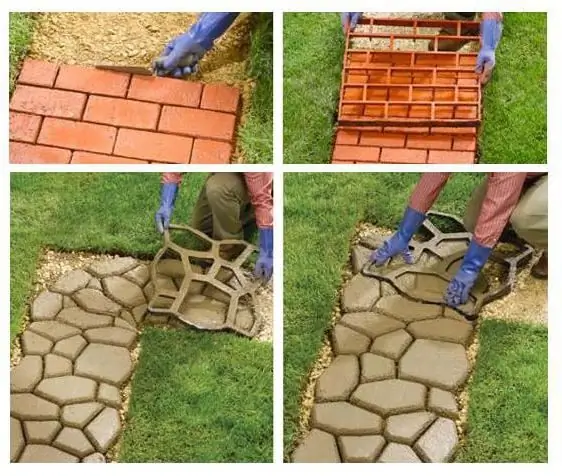
How to do it yourselfmake shape
For the manufacture of a sidewalk path, you can pick up any blanks. Some crafters use plastic food containers. However, choose strong containers that do not crunch. They are able to retain their shape after several pours, so they can be useful for creating tiles.
It is much easier to make a sidewalk path with your own hands if the workpiece resembles a rectangle. Don't use fancy containers. Otherwise, laying will become much more complicated.
Some owners make their own form, using any available materials for this. For example, from wood, you can create a regular hexagon, hollow inside. Such a blank will allow you to create tiles that will ideally adjoin each other.
Preparatory work
Having determined the width and location of the path, mark the area with pegs and a rope. The form for the sidewalk path has, as a rule, uneven edges. But each blank, like a puzzle, adjoins each other perfectly.
So where to start:
- Dig a trench along the intended bed. Its depth is 8-10 cm. Tamp down the ground.
- Pour pebbles or rubble. About 3-4 cm.
- A layer of river sand (5-6 cm) should go on top. Pour plenty of water over it.
- When using molds, be sure to lubricate them with machine oil (or any other). This will allow you to easily remove the workpiece.
- For the mortar you will need the following ingredients: 1 part cement, 3 parts sand, 4 parts gravel. After the introductionspecial binder mixture, you can add water and mix the solution.
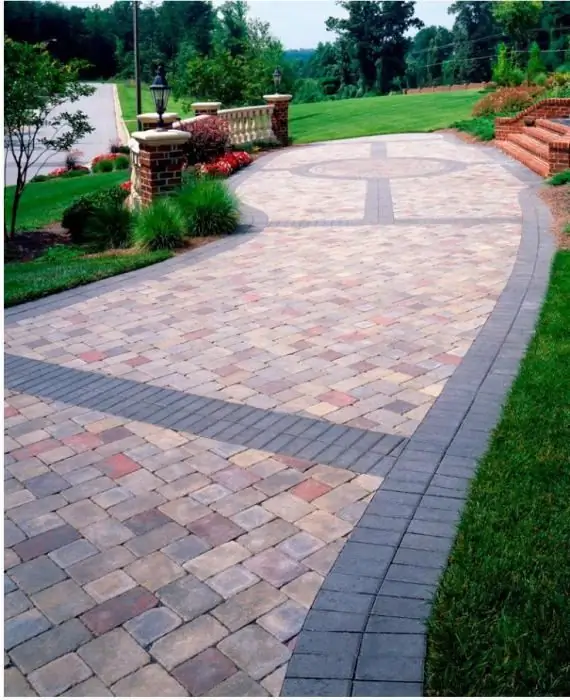
Installation tips
Having finished with the preparatory work, we proceed to the main stage. Any sidewalk path is made according to the following principle:
- The form is laid out in the area reserved for the path.
- With a trowel, it is filled (to the brim) with mortar, while avoiding the formation of air bubbles.
- Excess is removed with a plastic (iron) rail.
- After 30-40 minutes the solution will "grab" and the form can be carefully removed.
- Shift the blank to a new location on the future track and repeat the procedure.
- Semi-raw tiles can be decorated with colored tiles, porcelain stoneware, various stones or other material.
- Remember that your paving slab is still wet. Therefore, protect her from the encroachments of households and animals.
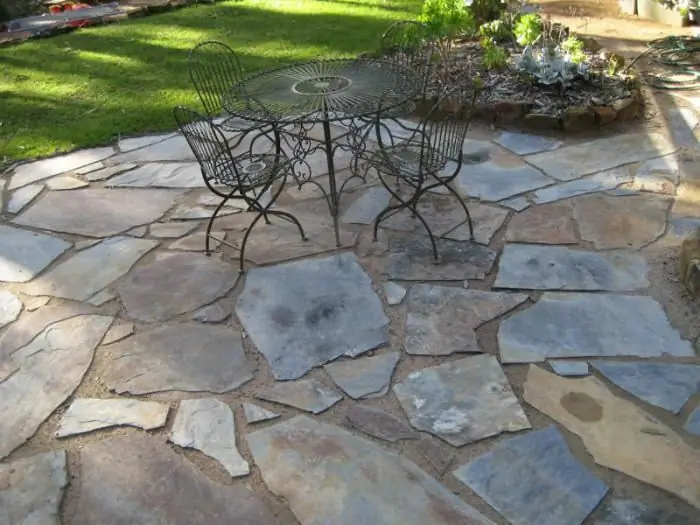
Original solutions
As you can see, making your own sidewalk garden paths is not difficult at all. Having de alt with the execution technique, connect all your imagination, and then your path will become a real design masterpiece.
You might find some of the following tips useful:
- The combination of rough frost-resistant tiles with brick looks harmonious. Such a path can give the garden a Mediterranean luxurious style.
- Small patches of grass between the pavedplates.
- Wide paving slabs supplemented with gravel look original.
- By adding dye to the solution, you can get a path of various shades. At the same time, the path looks advantageous, in which only some elements are colored.
- During pouring, you can apply a variety of details. This will create an unusual surface.
- An original solution would be to add illuminated tiles. This path looks especially beautiful at night.
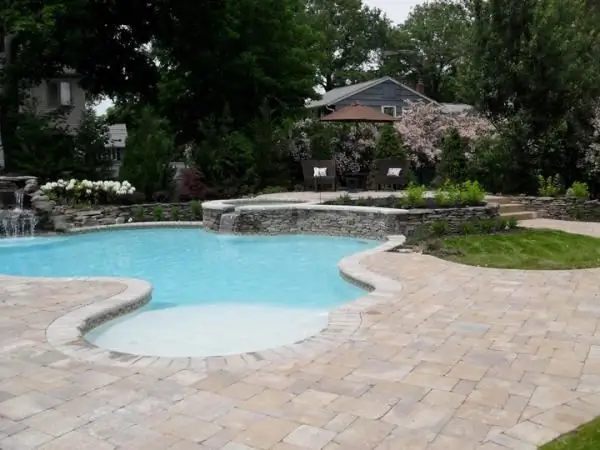
Conclusion
Consider before creating sidewalk paths, photos posted in the article. Some ideas can push you to create a real masterpiece that will become your pride.






